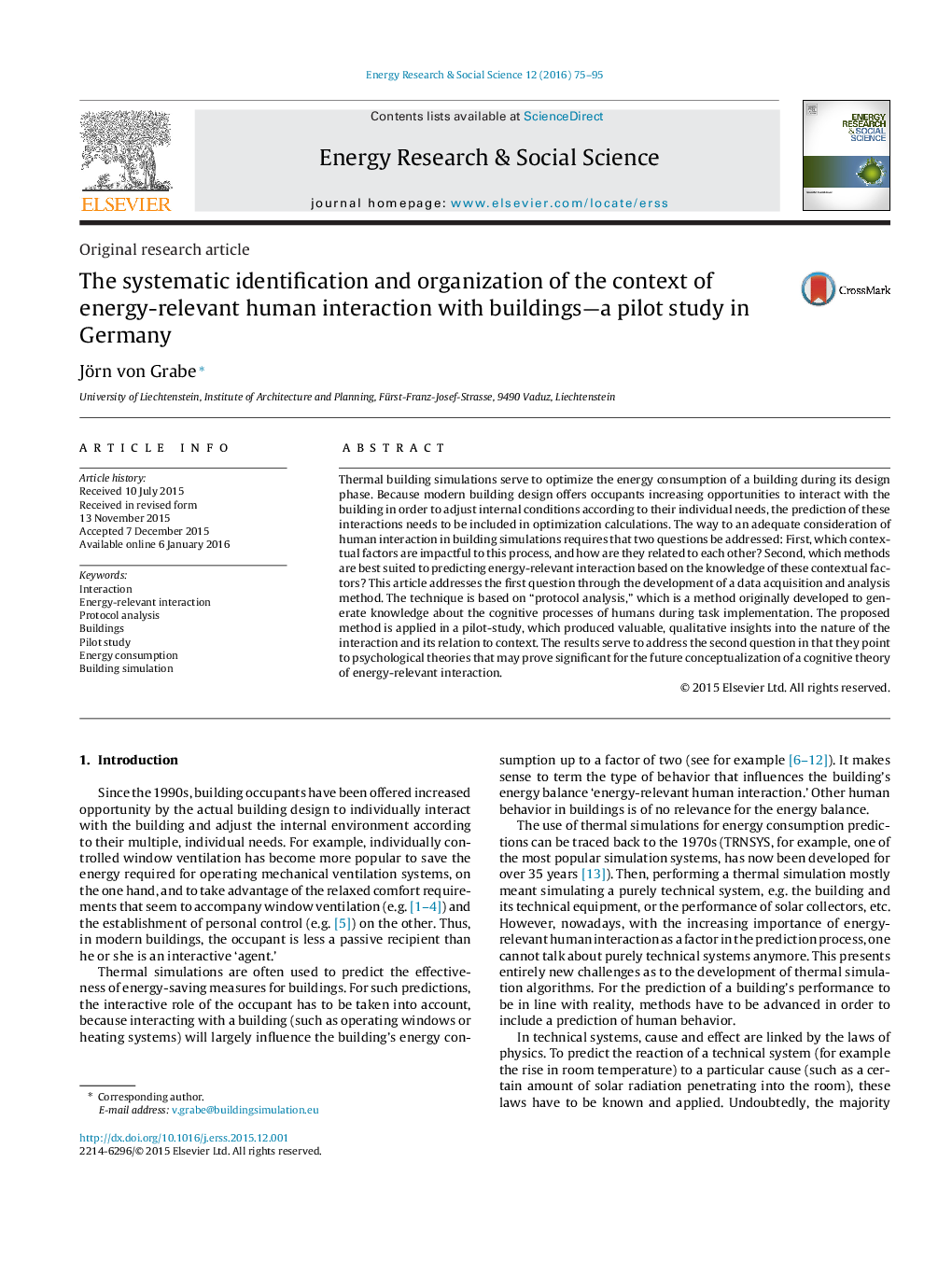| کد مقاله | کد نشریه | سال انتشار | مقاله انگلیسی | نسخه تمام متن |
|---|---|---|---|---|
| 6558327 | 161866 | 2016 | 21 صفحه PDF | دانلود رایگان |
عنوان انگلیسی مقاله ISI
The systematic identification and organization of the context of energy-relevant human interaction with buildings-a pilot study in Germany
ترجمه فارسی عنوان
شناسایی سیستماتیک و سازماندهی زمینه تعامل انسان با ساختمان های مرتبط با انرژی - یک مطالعه آزمایشی در آلمان است
دانلود مقاله + سفارش ترجمه
دانلود مقاله ISI انگلیسی
رایگان برای ایرانیان
کلمات کلیدی
اثر متقابل، تعامل انرژی مرتبط، پروتکل تجزیه و تحلیل، ساختمان ها، مطالعه آزمایشی، مصرف انرژی، شبیه سازی ساختمان،
ترجمه چکیده
شبیه سازی های حرارتی در خدمت بهینه سازی مصرف انرژی یک ساختمان در طول مرحله طراحی آن می باشد. از آنجایی که طراحی مدرن ساختمان باعث می شود که اشخاص فرصت بیشتری برای ارتباط برقرار کردن با ساختمان برای تنظیم شرایط داخلی با توجه به نیازهای فردی خود داشته باشند، پیش بینی این تعاملات باید در محاسبات بهینه سازی شامل شود. راه مقابله مناسب با تعامل انسان در ایجاد شبیه سازی نیاز به این دارد که دو سوال را حل کنیم: اول اینکه عوامل متفاوتی برای این فرآیند تاثیر می گذارند و چگونه با یکدیگر ارتباط دارند؟ دوم اینکه، کدام روش بهترین پیش بینی تعاملات مربوط به انرژی براساس دانش این عوامل متناظر است؟ این مقاله به اولین سوال از طریق توسعه یک روش جمع آوری داده ها و تجزیه و تحلیل داده شده است. این روش بر اساس یک پروتکل تجزیه و تحلیل، یک ؟؟ که روشی است که در ابتدا برای تولید دانش در مورد فرآیندهای شناختی انسان در حین انجام کار تعیین شده است. روش پیشنهادی در یک مطالعه آزمایشی کاربرد دارد که بینش کیفی و ارزشمندی را در خصوص ماهیت تعامل و ارتباط آن با زمینه ایجاد می کند. نتایج برای پاسخ به پرسش دوم به این موضوع اشاره دارند که آنها به نظریه های روانشناختی اشاره دارند که ممکن است برای مفهوم سازی آینده ی یک نظریه شناختی از تعاملات مرتبط با انرژی مورد توجه قرار گیرد.
موضوعات مرتبط
مهندسی و علوم پایه
مهندسی انرژی
انرژی (عمومی)
چکیده انگلیسی
Thermal building simulations serve to optimize the energy consumption of a building during its design phase. Because modern building design offers occupants increasing opportunities to interact with the building in order to adjust internal conditions according to their individual needs, the prediction of these interactions needs to be included in optimization calculations. The way to an adequate consideration of human interaction in building simulations requires that two questions be addressed: First, which contextual factors are impactful to this process, and how are they related to each other? Second, which methods are best suited to predicting energy-relevant interaction based on the knowledge of these contextual factors? This article addresses the first question through the development of a data acquisition and analysis method. The technique is based on “protocol analysis,” which is a method originally developed to generate knowledge about the cognitive processes of humans during task implementation. The proposed method is applied in a pilot-study, which produced valuable, qualitative insights into the nature of the interaction and its relation to context. The results serve to address the second question in that they point to psychological theories that may prove significant for the future conceptualization of a cognitive theory of energy-relevant interaction.
ناشر
Database: Elsevier - ScienceDirect (ساینس دایرکت)
Journal: Energy Research & Social Science - Volume 12, February 2016, Pages 75-95
Journal: Energy Research & Social Science - Volume 12, February 2016, Pages 75-95
نویسندگان
Jörn von Grabe,
